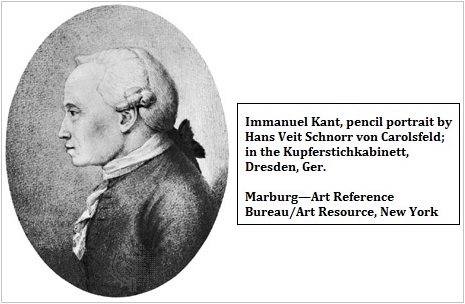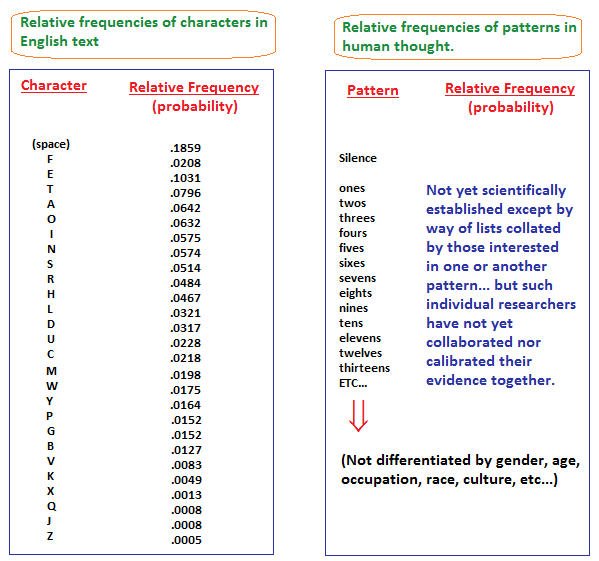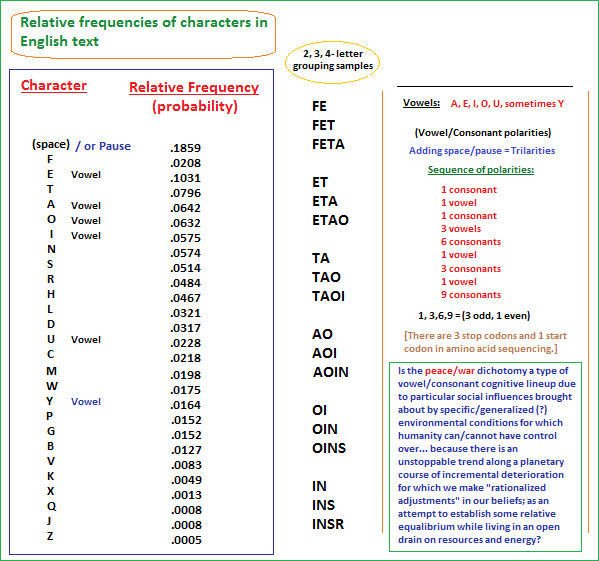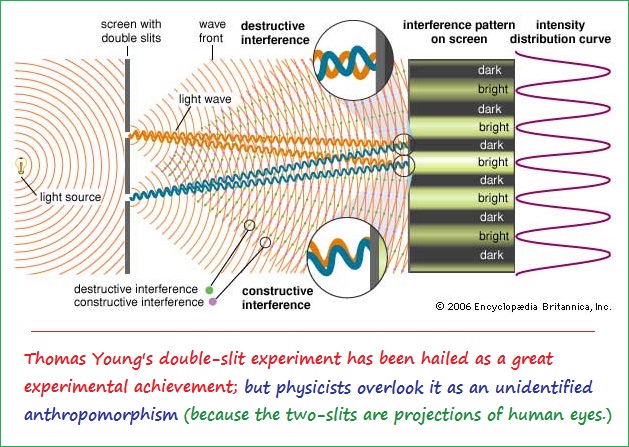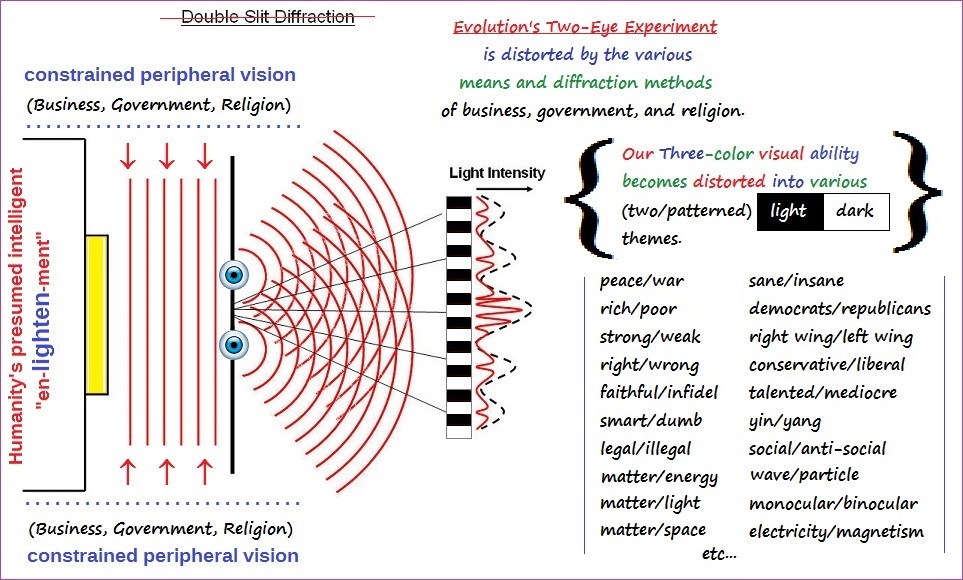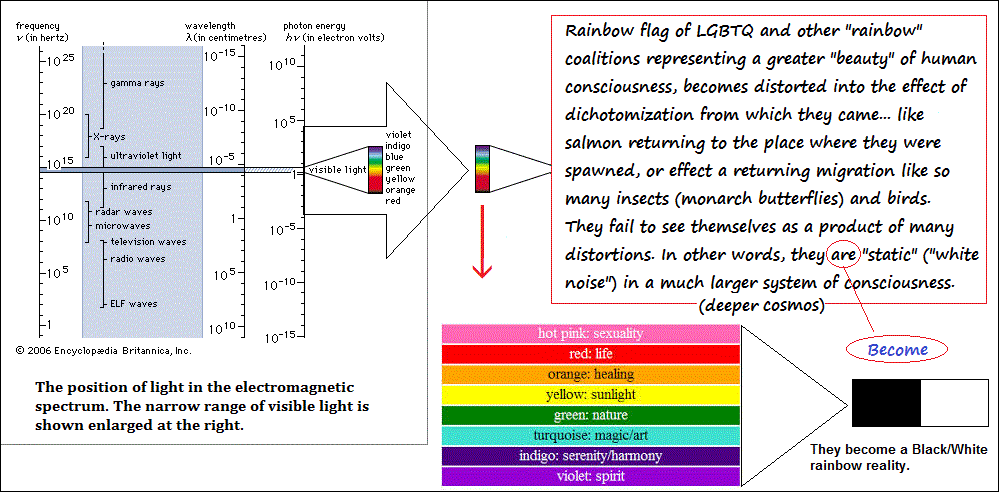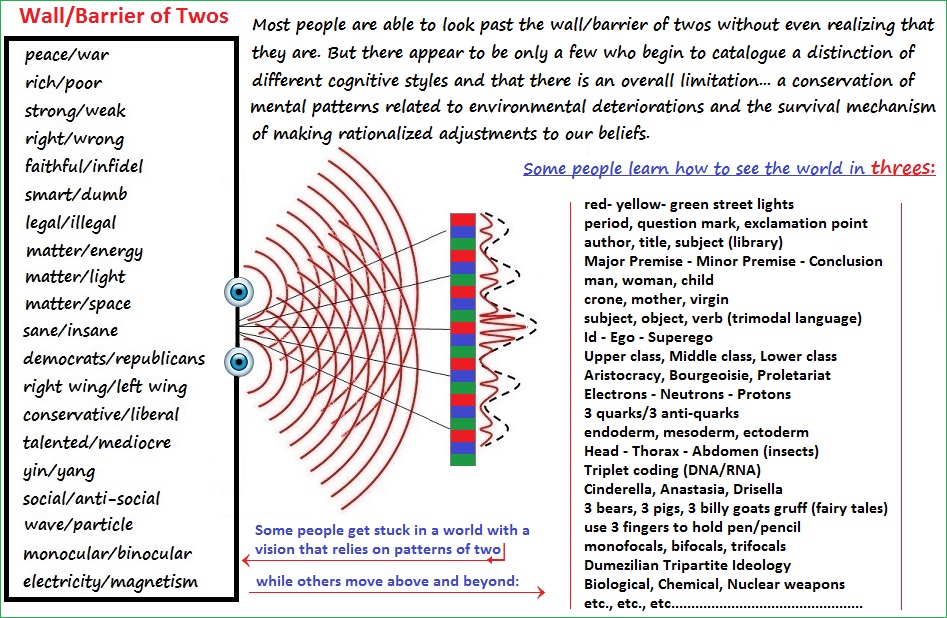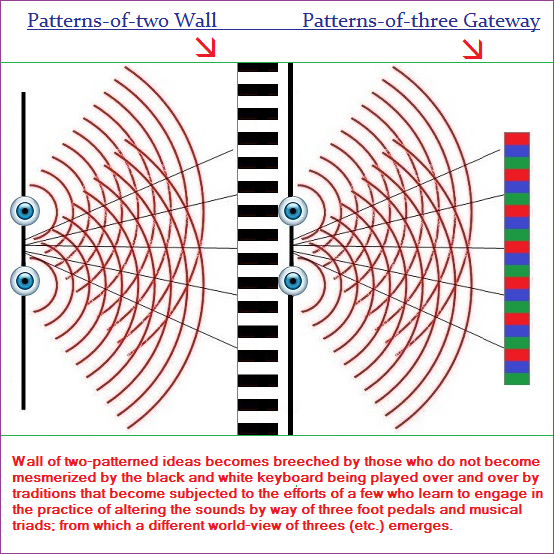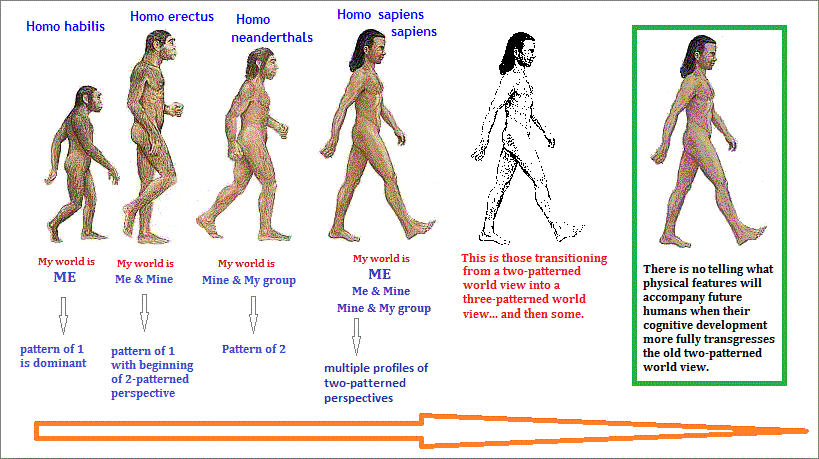(Those who think in threes)
http://threesology.org
Let me start off by describing the atmosphere which has been generated because of the competition amongst researchers, scientists and other intellectually-oriented types who engage in their respective pursuits like many an athelete does: by doing whatever... and to whomever they can in order to further their "win". By this I mean they will cheat, steal or use (what they believe to be) performance enhancing drugs to improve memory and associated physical stamina. They adept themselves to the requiste "game rules" for publication, speaking and social networking... even though they have no real contribution to make. They may "walk the walk" and "talk the talk" of their intellectual genre, but they are little more than a figurine amongst other figurines put on display by those who share their interest and want to maintain their views as a standardized discipline.
For example, many decades ago while as a young man, I was interested in rebuilding internal combustion engines and modifying vehicles for speed and off-road performance. At one time, I came across an individual who was a virtual encyclopedia of performance parts... both after-market and those being offered at the time through dealerships. Yet, despite his ability to present himself as being quite knowledgeable and persuasive, a few questions about engine building particulars provided the fact that he had never taken an engine apart, much less put one together. It took a little coaxing, but he finally admitted that he wasn't actually a mechanic... he was simply an enthusiast, but his knowledge was not simple by any means. If you were wanting to know alternative considerations for a given part or application, he was indeed useful in this respect, and he was respected for it... even though some would-be "real mechanics" did not appreciate him for his aptitude. However, in order to realize how well versed he was in the material, you would have had to have a wide-spectrum knowledge yourself. Fortunately, I liked to read as well as roll up my sleeves. In short, while he "talked the talk" and very much played the part of "walking the walk" of a mechanic, it was "all show and no go"— as they used to say in past show-and-tell hot-rodding ages. No doubt some readers have encountered some variation of a "shade tree" mechanic in one or another research interest or activity.
"Threesology" or "Threenking" can be viewed as a formula of number theory related to mathematics. The history of numbers as an expression of thought processing, can help us grasp humanity's developing cognition which includes science, since science frequently involves the usage of applied numeration such as quantity of subjects used in an experiment, the amount of questions in a test, the number of answers provided for a question and how a test might be numerically illustrated in a graph. However, what is often overlooked is that the earliest forms of quantitative organizations such as making marks on a stick, piece of bone, rock or whatever was available, was not necessarily aligned with a word such as one mark represented the value "1" or "one", "uno"... or other language-equivalent word. The history of numbers can be thought of as signaling a cognitive change, just as does a person's increased usage of enumeration&mash; and can be used as a tell-tale sign of their relative cognitive patterning.
Yet, let me emphasize that while one person may use "real" numbers such as 1, 2, 3, another person may have a mathematically oriented cognitive pattern which utilizes some other type of patterning... such as words, gestures, pictographs, or else wise... and may be similar to the behavior we see in some students who for one reason or another do not want to "show their work" in order to reveal how they are addressing a problem so that an instructor (teacher) can assist them in correcting errors in their thinking. Without aknowledging it to one's self, a person might be inclined towards participating in the usage of unrealized "word problems", or some other kind of mathematical-like processing of the brain using sounds, feelings, notions, or whatever pattern(s) they are exposed to in their respective environmental circumstances. For example, instead of being involved with an accounting or mortgage firm using double-entry methodology (which is a flavor of dichotomous thinking), I have employed a different accounting process by cataloguing various word and graphic-related enumerations beginning with patterns-of-three, but has now expanded far into other realms of consideration... which includes "The Cognitive Basis of Science" which can be alternatively described, for example, as "The Development of Scientific Cognition (thinking)" or "The Origin(s) of Particularized (enumerated) Thinking Processes in Science, Mathematics, Politics, Sociology, Psychology, Anthropology, History, Music (including music theory), Medicine, Art— etc...". Enumeration and mathematical processing does not have to involve the "real" numbers (as opposed to standardized algebraic analogies or metaphors). If a person is adept at using an abacus but an abacus is not permitted in a given instance, they may apply their inclined behavior in some other formula that seems strange to onlookers... because it is a mental language they are not familiar with. If they become adept in using this alternative "brain language" and others begin "speaking" it— whereby a small community develops, the fluency may become quiet fast and/or sophisticated.
Not only is it of interest to determine when the "cognitive leap" to enumeration took place, but how it took/takes place, how it is continuing, and if it is improving or getting worse... as well as whether or not it is assisting in the improvement of humanity... that is if humanity is a value of life to sustain more than a few million years into the future, as it has believed to have done a few million years into the past. (In other words, is humanity a "goal" of life/evolution, or a mere stepping stone, or neither?) Clearly, there appear to be distinct "languages" of enumeration, one of which is to use references thereof in the way one verbally articulates or in the way they write. For example, it can be said that all of us use periods, question marks and exclamations, yet only a few are conscious of whether or not all three of them are used at any given time. While some people express themselves in various patterns-of-three quite often, some people use patterns-of-two or patterns-of-one. Some may frequently use terms that can be related to mathematical processes such as sum, total, equivalent, divide (division/divides), add, gain, loss, subtract (take away), etc., others don't. Some may give one, two or three examples, while others don't. Some may try to provide an illustration of their thoughts by usage of an anology (analog: one -to- one correspondence), others appear to be more digitally oriented in their expressions. Using a "Threenking" approach to an analysis of thought processing provides a whole different perspective of human communication and overall behavior.
For example, does a person's type of enumeration reveal a developmental change in thinking related to physical changes in the brain like that seen when encountering the maturational development of an individual from infancy to childhood and later on... despite the changes recognized due to nutritional excesses or deficiencies including mental illness, drug and alcohol abuse or some other seemingly innocuous obsession? Indeed, let us also ask if those who think in terms of a reliance on frequent enumeration can be viewed as "better" thinkers, or simply a different type of thinker who may or may not belong to an influential social group of like-minded others? Hence, "Threenking" can be viewed as a model of investigation into the origin, usage and direction of human cognition (thinking) relative to the planetary environment as it proceeds along its path of incremental decay, forcing us to make "rationalized adjustments" in our belief systems in order to gain or maintain some semblance of survival equilibrium.
As with previous home pages, this one supplies links which reference different approaches towards thinking about the "threes" concept. Whereas some devise a philosophy based on a personalized interpretation and analysis, others take on the enormous task of cataloging the many hundreds and hundreds and hundreds of examples:
- Michael Eck's (Tricyclopedic) Book of Threes
- Dr. McNulty's List of Threes in human anatomy
- Simon Kelsey's Triplicity- The Phenomenon of Threeness in Life
- Tom Van Gelder's Phenomenology - Threefoldness
- Dr. L.B. Croft's People in Threes Going Up in Smoke... and Other Triplicities in Russian Literature and Culture
- James Shapiro, Raju Pookottil, and Denis Noble's "The Third Way of Evolution"
Here are three links for Dr. Dundez's article "The Number Three in the American Culture" which appeared in an old 1967-1968 book entitled "Every Man His Way" (which is a collection of different Cultural Anthropology readings):
Some of you who come to this page are already familiar with the efforts of some to collect ideas, pictures, expressions, etc., into groups of three, even though you personally may have an interest in twos, fours, fives, sixes, sevens or some other number value. And though some of you may think that all "Threenkers" are only interested in patterns-of-three, let it be understood that some of us take a much broader perspective of the "threes" phenomena... in that it has a place amongst a group of other number-related patterns such as those already mentioned as well as others. However, when we attempt to make a list of the different patterns, we find that we are only able to identify certain patterns either because of prevailency or perhaps of some unrecognized inherent inclination of the human species. Anyway, the following chart is a thrown-together example of what a cataloging of different number patterns might look like:

Your individual experiences with one or another pattern might well influence you to create a chart with a different distribution. Nonetheless, what we can see is that there is a limitation to both number and complexity. It's not that we can't think in larger number values or that we can't think in more complex terms, it's just that the appearance of this illustration indicates there is something causing the conservation... or if you prefer, the limitation. Since we at present only know of biological sentient life as being on the third planet from a Sun, does this mean life (at least as we know it) can not evolve on a planet that is in the 4th, 5th, etc. position? Does this mean that all brands of genetics throughout the Universe has to exhibit a triple coding system? Do all sentient beings have to have two eyes (despite the claims for a third or mind's eye)? Must all humanoid forms have a mechanism of hearing that is particularly three-based as that of humans? (See: Language 3's page 1)
If the chart represents the existence of an unidentified (or at least unstudied) conservation law to add to those in physics, what might it possibly mean for humanity? Let's take a moment to review the topic of the "conservation law" so that the reader might better grasp what I'm referring to:
(The Conservation law) in physics, (refers to) several principles that state that certain physical properties (i.e., measurable quantities) do not change in the course of time within an isolated physical system. In classical physics, laws of this type govern energy, momentum, angular momentum, mass, and electric charge. In particle physics, other conservation laws apply to properties of subatomic particles that are invariant during interactions. An important function of conservation laws is that they make it possible to predict the macroscopic behaviour of a system without having to consider the microscopic details of the course of a physical process or chemical reaction. Source: "Conservation Law." Encyclopædia Britannica Ultimate Reference Suite, 2013. |
An operative phrase mentioned above is the "isolated physical system", of which humans are presently subjected to with respect to their relative confinement on Earth and this solar system/galaxy... like bacteria or a virus in a petri dish. However, the physical system of the Earth is heading along a sustained course of incremental deterioration, and biological creatures are being forced to make adjustments to it as a means of maintaining some measure of equilibrium. Here is a list of some ongoing deteriorations:
- The Universe/galaxy are expanding, creating larger distances between other potential Earth-like planets.
- The Sun's energy is continuing to burn out. It is thought the Sun will one day expand to engulf the innermost three
planets (though debate on this continues.)
- The rotation rate of the Earth continues to slow, thus affecting the electro-magnetic dynamo due to the molten core (becoming static).
Thus conversely, the Earth's rotation was much faster in the distant past which presented developing life with a three-pattern stroboscopic
irradiation of dawn-noon-dusk.
- The Moon continues to recede (move away) from the Earth, thus altering the tidal "washing machine" effect.
The incremental deteriorations are going on at this moment and require biological life forms to make incremental changes as part of an on-going re-adjustment process... whether you or I or anyone else is consciously aware of the alterations or not. Much like a group of people on a deteriorating raft on an ocean who must incrementally alter their perceptions as a measure of survival equilibrium to "make the best of a bad situation"; the alterations can be labeled rationalized adjustments that are then replaced by rationalized adjustments to the former adjusted rationalizations. Hence, all businesses, governments, religions etc., are rationalizations atop rationalizations atop rationalizations... despite all the added intellectual tools used to measure reality we are biologically able to perceive and make use of, in order to make the best guess as to who we are, where we are, and in which direction we think we're headed— despite the so many blind alleys or cul-de-sacs we have found ourselves in. Observed pragmatisms are not always the best course since they are derived from a known set of criteria which may be lacking in a larger body of knowledge. Pragmatism is just a brand of rationalization that may work well in a closed system, so long as the system is not given to change within the time period in which the pragmatic orientation is applied as a rule-of-thumb set of tools.
On the human scale of adjustments, there are changes in the way people think; to which we might want to apply the notion of "rationalized adjustments". If the appearance of different numerically identified ideas is related to developmental changes (physical and/or mental... or emotional), then we might see a change in the distribution of numbers which differ from the hypothetical array presented in the above graph. The problem is, much of what we are cataloging is the development of a new approach at understanding human cognition... though other life forms exhibit numerical index preferences as well. In other words, we don't have previous charts to rely on for comparison. Most of our efforts are stymied by those whose interest in one or more number-related models associated to ideas revolves around some personal interest such as in theology, numerology or some pseudo-scientific application.
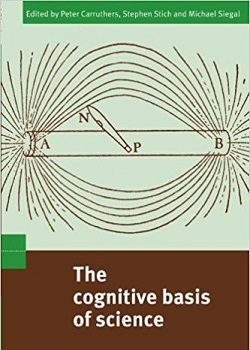
In an effort to ascertain whether main-stream academians have arrived at an appreciation of what we "threenkers" have been trying to convey, I have been reading a (2005) book entitled "The Cognitive Basis of Science" edited by Peter Carruthers, Stephen Stich and Michael Siegal; which is a collection of essays by different authors who are tackling the notion of developmental cognition... with respect to thinking in terms of what may be described as scientific constructs. In plain English, they are addressing the issue of when, where and how and in some respects, who developed a "science mindfulness". For example, findings of experimental ideas using children... as an expression of developmental primivity, is explored in an attempt to establish what some consider to be an effective base-line for comparing later adult mindedness in the area of science... even if the word "science" is not obligingly defined but presented by way of criteria which are assumed to be science because particular types of thinking are labeled as such. The first chapter (after the introduction) (by Steven Mithen) goes into the realm of attempting to develop a scenario of origination from the distant past by an examination of different hominids, yet it does not go far enough back in time nor include a larger appreciation of environmental influences such as described in the Are humans rotation rate specific? For example, because we find many "scientific" ideas using patterns-of-two and patterns-of-three in their descriptive appraisals, it is of value to consider what environmental influence may have set such patterns in motion, such as the night/day sequencing and the three-patterned stroboscopic solar event. But it is a short paragraph from the second chapter (by Scott Atran) which I want to highlight at this moment:
Section 3.4, (Folk-specific): Generic species may be further divided into folk-specifics. These taxa are usually labelled binomially, with secondary lexemes. Compound names, like white oak and mountain robin, make the hierarchical relation transparent between a generic species and its folk-specifics. Folk-specifics that have (a) tradition of high cultural salience may be labelled with primary lexemes such as winesap (a kind of apple tree) and tabby (a kind of cat). In general, whether and how a generic species is further differentiated depends on the cultural significance of the organisms involved. Occasionally, an important folk-specific taxon will be further sub-divided into contrasting folk-varietal taxa: for example short haired tabby versus long-haired tabby. Folk-varietals are usually labelled trinomially, with tertiary lexemes that make transparent their taxonomic relationship with super-ordinate folk-specifics and generic species, for example swamp white oak.
While the author differentiates between "bi-nomial" and "tri-nomial", there is no indication that the author grasps the "two" and "three" differentiation as cognitive categories in and of themselves, such as the presence of a 1, 2, 3 illustration in the form of a one-word "winesap", two-words "white oak", and three-words "swamp white oak" example. The usage of such patterning is a tale-tell sign of human cognition that is being overlooked by many researchers. One need only look at the manner in which people are themselves named to see a cognitive parallel. For example, earlier humans might be signified by referring to one another in relation to a place, occupation, or physical trait. For example, the last name of a person may designate a place or historical event associated with the name. Some genealogists are inclined to think of names according to their historical origination, while others may be primarily interested in family histories.
Nonetheless, in many instances in the past... a person may have acquired a one-word name such as "Red" or received a three-word designation such as "Eric the Red". With respect to the fictional names of "Snow White", "Cinder-ella", "Goldilocks", "Little Red Riding Hood", "Rumplestiltskin", "Pinocchio", "Peter Pan", the (Walt Disney studio) names of the seven dwarves (Bashful, Doc, Dopey, Grumpy, Happy, Sleepy, Sneezy), "Pied Piper", Butcher, Baker, Candlestick maker, etc... we can see recurring basic cognitive patterns... made distinct by way of enumeration. (In other words, the names are singular, though some such as the four-word "Little Red Riding Hood" can intimate an occupational or behavioral reference... though we do not know if the girl rode anything when wearing a red hood. We don't actually know her name... and like a stranger, we might also refer to her by something she was wearing... because even though the story about her is famous, none of us actually know her.) However, the fame which many fairy and non-fairy tales have been perpetuated has caused some to reflect on the possibility for introducing a different type of childhood genre so as to not perpetuate direful social standards that appear to be repeating. In other words, some people think that the stories told to children generation after generation need to be altered in order to give humanity hope for a new and better future. As it is, Fairy tales, Biblical stories, and cartoons are frequently about violence and other behavior we don't want children to have, but are exposed to again and again and again.
Correlating a person with a place, event, physical feature, or some other qualitative designation is a form of scientific reasoning. If necessity is the mother of invention, than a lack of needing a more distinctive means of name-designation contributes to the lack of developing a larger need for a greater scientific rationale. If the day -to- day lives of most people don't channel them into more complex forms of scientific reasoning, then the level of scientific analysis remains in its generic, folk-specific formula. Why some people are inclined towards developing a more refined value thereof involves variables of both nature and nurture as a life process. Even today a "folk-specific" behavior is indicated in the habit of referring to a person by their first or last name, or in some cases a nickname, unless they prefer their middle name. In other venues they might be referred to by a designation as "Dr." or Md., with or without a further specificity such as Dr. Smith, Captain Jones, Seaman Michaels, etc... In other instances we find people having a first and last name, but no middle name. In some references, history has provided us with examples of those who were referred to by title such as Duke or Duchess, along with a place and perhaps profession and/or egotistical embellishment. But in most cases, we see a one, two, three pattern amongst the labeling of people. Indeed, it's almost as if the whole of humanity is engaged in a type of unrecognized behavior of participating in an accountant's ledgering efforts, where "double-entry" accounting very often takes place in the form of dichotomization. And if we take an example from music, the act of keeping a numerical ledger of sorts can be seen in a description such as solo (one) and duo (two) sonata, piano trio (three), string quartet (four), concerto -or- symphony (much/many). Yet, all of cognitive theory, however so named (philosophy, psychology, anthropology, music theory, sociology, etc., could just as well be seen as modernized forms of headhunting.)
However, in chapter 12 of the aforementioned book "The Cognitive Basis of Science", we find the following chart as illustrated on page 238, in a chapter entitled "The Passionate Scientist: Emotion in Scientific Cognition" by Paul Thagard. It is a chart listing types of emotions deduced from an account given by James Watson about the discovery of the DNA structure. (In other words it is a catalogue displaying the types and amounts of emotions represented in the book by Watson, even though the story is held in suspicion because of the controversy involving the findings of Rosalind Franklin's X-ray diffraction being shown to Watson well as the lack of recognition that others (Linus Pauling, Maurice Wilkins, Rosalind Franklin) should have shared equally at the time. Because of the controversy involving the discovery, since many think Watson and Crick would not have made the necessary cognitive connection as to the DNA structure being a double helix because they had been committed to a triple helix configuration.)[Revisionist information about DNA structure story which gives credit to the group of five: Wikipedia: Maurice Wilkins]
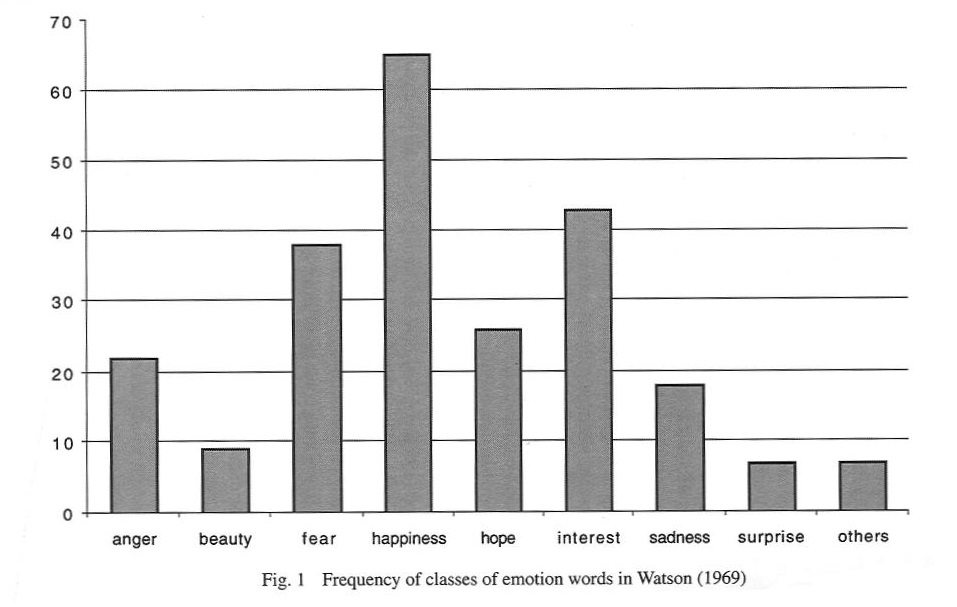
The types and amounts of different emotions are quantified, that is...associated with a numerical value... and yet the ideas throughout the book are not set into a similar frame of mind-reference with respect to quantification as a tell-tale sign of cognition related to those contributing ideas about cognition. In other words, the authors, as counters of scientific patterns, are not having their ideas subjected to the same type of quantitative analysis in order to describe how many times given numerical representations are being used in their descriptive analysis. It is the same over-sight occurring when peace is analyzed... as a representation of human cognition. But if we take the same chart and change the listing of items from emotions to numerical indices related to the numerical patterns of ideas, we arrive at a hypothetical representation concerning the contents of the book from which the above chart was garnered.
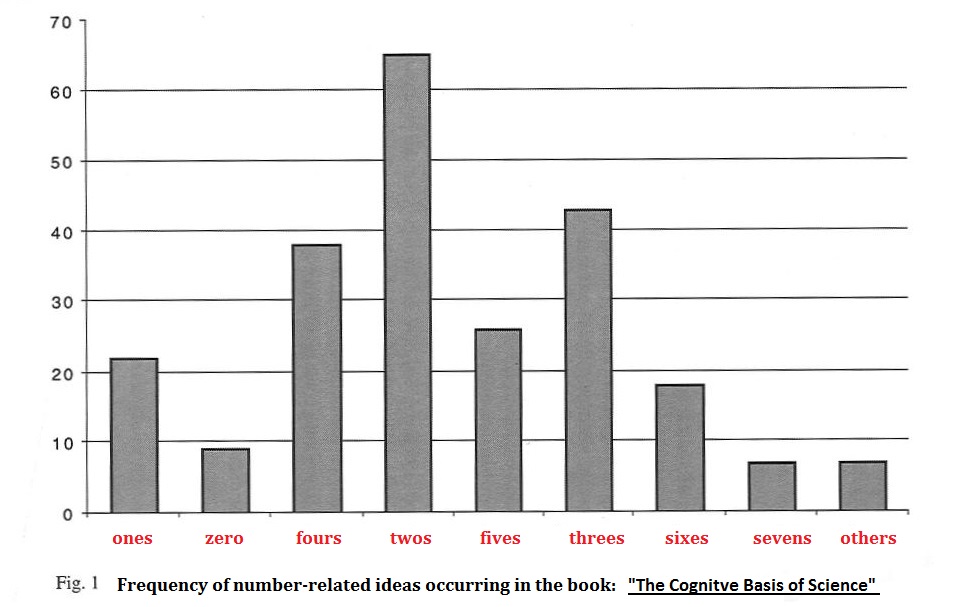
The chart is not meant to relate to the actual occurrences of number-patterned ideas distributed in the book, but as a simplified illustration of an alternative approach at understanding human cognition. It goes without saying that some reader will take up the task to develop a chart illustrating the expressed patterns of enumerated ideas occurring in the book. When you have, let me know and I will place it on-line giving you full credit for your work.
And yet, in reflection (taking place the next day after I wrote the above), I think that I need to tackle the illustration project myself, even though I am involved with the construction of other pages. (See below for the listing of the first three chapters.) It needs to be formulated from the perspective of someone that not only has a "threesological" perspective, but also someone who understands how intellectuals use intellectualization to digress from, conceal or advance the same overt, covert and psychologically referenced dimensional instances as impulsive inclinations, intimations, intimidations, etc., that others have such as with respect to expressions of bullyism, voyeurism, incest, rape, lust, greed, generosity, magnanimity, hope, charity, aggression, theft, murder, etc... In other words, whereas some people express desires, emotions, and the entire spectrum of human activity along channels which are considered immoral, questionable, and/or criminal, scientists are not necessarily the good guys (and gals) they are sometimes presented as being. Not all of them seek to use their intellectual ability to promote or foster events and/or activities or products which will be of benefit for humanity. Instead, if one looks closely, we see the same interests and inclinations that "normal" (non-professional scientists) have, but that such activity takes place on an intellectual activity which may use a research activity to express a vicarious representation. For example, a scientist involved in the sexuality of an plant, insect, or animal, species may do so as a means of expressing their own preoccupation with sex that finds an acceptable outlet if channeled along a non-human arena of activity. In as much as this is well known to many, the understanding that scientists are ordinary people is sometimes lost in general considerations when speaking of science and scientists. Many of them are just as ignorant about one or another simple fact about this or that topic as the rest of the public who may not customarily think in terms of sublimated behavior when viewing the activities of scientists.
And in as much as one might analyze any text from the perspective of seeking out representative words and phrases which are suggestive of a given subject (such as deciphering words in relation to sexuality or sexual activity such as life-birth ["brain-child"], death-decadence {"result"}, insertion, reception, mixture, etc...), that is not the direction undertaken by the present exercise. Indeed, I am in pursuit of a different quarry using an experimental form of hunting and gathering technique.
As such, with respect to devising the criteria by which a "threesological" analysis of "The Cognitive Basis of Science" book should be undertaken, there is a need for distinguishing what is to be catalogued so that future researchers will better be able to determine deficiencies... just as we might want to determine whether writers in past centuries used more, less, or the same amounts and types of numerical referencing ideas as we of the present do. For example, there is of need to distinguish the presence of:
- Specific numbers: 1, 2, 3... etc...
- Specific Number words: one, two, three, etc...
- Generalized Number words: single, double, triple, etc...
- Mathematical operations: dichotomy (division), collation (addition), magnification (multiplication), separation (subtraction), etc...*
- Quantitative references: much, many, alot, bunch, few, forked (forked-tongue), etc...
- Quantitative orientations: group, separation, collection, etc...
- Quantitative illustrations: graphs (X,Y), (X,Y,Z), (W,X,y,Z), etc...
- Geometric numbers: triangle = 3, square = 4, octagon = 8, etc...
- An author's use of a word, phrase, picture, notion, punctuation, etc., to portray a numerical reference that they were or were not aware of.
- Idiosyncratic number/non-number uses or referencing (such as placing such at the beginning, and/or middle, and/or end of a given text).
- Does a particular author use a particular self-styled enumeration with which to present ideas, as if using a code they may not be aware of?
- Do some authors rely on word, paragraph, page, volume or publication counts as personalized references?
- What are we all trying to describe and why can't we actually describe it in accurate terms?
- Why do all of our ideas express a personalized generalization unless that which is being talked "about" (around-about or nearby, but never
specifically at), is a dynamic... is a generalization itself?
- Is the truth one seeks in or about nature a shot-gun effect type of inquiry because truth is not itself permanent?
*Not to mention operations involving calculus, algebra, geometry, etc., or the application of other subjects as attendant characteristics such as one might sight the "music" in a poem, the "beauty" of a math equation, the "evolution" of a new genre in thinking, the "mechanics" of military strategy, the "cornerstone" of one's career, the "architecture" of a computer program, and various other applications that may or may not be meant solely as a metaphor, etc...
The following words are not placed in accordance with sequential appearance, but approximate rate of occurrence in the overall chapter. Dates and ages were omitted, as were words/leters such as "a", "I", "us", etc., that can give an account of quantity... as well as reference listings of other authors. There was no overall word, paragraph, nor punctuation count conducted. Illustration, diagram types and forms were not counted. Directions nor geometric positions (up, down, in, out, north, west, etc.) were not counted, nor large quantity expressions such as bunch, many, total, etc., except as provided. But the word "one" was counted whether referring to person or object as a specificity or generality. Interestingly, individual numbers (1, 2, 3, etc.,) are particularly few. And yes, you might find that I missed an item or that you would prefer to count something else as a "number" word or one giving an expression of a mathematical operation. For the most part, I also overlooked information pertaining to chapter references and footnotes. None-the-less, the following account of the first three chapters (Introduction by Peter Carruthers, Steven Stich, Michael Siegal; 2 by Steven Mithen; and 3 by Scott Atran... provide information about the written form of articulated thinking processes of these cognitive scientists with respect to the context and mode of counting applied. Just as they conduct enumerated references and experimentation, a method of enumerating their thinking processes should also be used as if they were subjects providing data in a much larger assessment of human cognition. (In other words, the thinking processes of those crazy scientists and philosophers needs to be scrutinized in order to give them a taste of their own medicine, with respect to being unaware of themselves as test subject guinea pigs. And similar to the required behavior of so very many test subjects in experiments, they are not able to "adjust" the experimentation to their own liking... even though some of the test subjects may want to engage in a little mischievousness in thinking they're smarter than the test giver and can throw a wrench into the test results... like many a college student has tried. HA!)
It is not known whether any of the authors have a "threesological" understanding of reality, and it should be noted that the "one" can be used to practice a type of depersonalization (in an attempt to become more "scientifically" objective) achieved via a third-person usage... such as not me, nor I, nor you... but some-"one" person or thing.
| Number word and quantity-references in 3 chapters of "The Cognitive Basis of Science" | |||||
|---|---|---|---|---|---|
| Introduction | Chapter 2 | Chapter 3 | |||
| Word | Frequency | Word | Frequency | Word | Frequency |
| one | 17 times | one | 18 times | one | 5 times |
| two | 10 times | two | 9 times | two | 12 times |
| three | 9 times | three | 3 times | three | 4 times |
| four | 1 time | four | 2 times | four | 3 times |
| five and six do not appear within criteria constraints | |||||
| seven | 1 time | seven | 1 time | seven | 1 time |
| eight, nine, ten, etc... do not appear within criteria constraints | |||||
| first | 1 time | first | 2 times | first | 6 times |
| second | 2 times | second | 4 times | second | 5 times |
| third | 0 times | third | 1 time | third | 3 times |
| fourth | 0 times | fourth | 1 times | fourth | 1 time |
| fifth, sixth, seventh, eighth, ninth, tenth, etc... do not appear within criteria constraints | |||||
|
From here on I will place different words that may or may not appear in each of the three accounts. If the word appears once, I will simply use the word itself as a representation of a single quantity. If it appears more than once, I will place the quantity within parenthesis: |
|||||
| number (6) | small number, great number | small number | |||
| added, subtracted | divided | addition, divides, divided, division, sub-divided, sum (4) | |||
| 4 | 3cm, 11cm | none, 0, 1 (5), 2 (5), 3 (4), 4 (2) | |||
| dual, dualism (4) | double helix, pair | pair | |||
| ones (2), one's (2), single (4), singly, secondary | once, one's, secondary (1), secondly | single, primary, primarily, secondary, binomial, binomially, binomials, trinomially, many (2) | |||
| first-person | bifacial, bifaces, bipeds, bipedalism | two-footed, four-footed, quadrupeds | |||
Yet, let us now make a comment about the enumeration of emotions as being related to an unacknowledged perception of different vibrations, though the term "music" is used to distract one from focusing on the underlying physics of vocal articulation related to cognition. Emotions have frequently been referred to as representations of physical states, but both categorizations with such labeling are themselves generalizations and that the word "vibration" may be assumed to be a more definitive portrayal, though "vibrations" is but another word like "emotion" in that it can relate as much meaning as "spirit", "ghost", "feeling", or some indescribable sensation. All our labels at attempted description fall short of any definitive except the ability to acknowledge generalization termed a specificity in one or another context of application.
Thus, whereas truth about a topic may be definitive for an instant or period of time stretching centuries, it is not "universal" (everywhere and for all time for all sentient beings) nor bound to infinity? Furthermore, it is not definitive truths that we may find... but only one's which can endure throughout a given life-span to provide psychological comfort of an assumed (relative) steady-state that eventually decays whether we or mulitple others recognize or believe in?
For example, just because lovers say that their love will last forever doesn't mean it will. Humans can hold beliefs to satisfy momentary inclinations of consideration to justify impulses or desires, but such beliefs can be nonetheless false even if they are maintained by tradition and Romanticism in order to suggest the exist of in "immovable order" deciphered by one's interpretations of life through the medium of music, math, philosophy, physics... or otherwise. Just because we put something into a repeating pattern to suppose a coherence or balance does not mean life actually complies with the pattern as a sort of an unvoiced correspondence principal we might imagine is shared between us and reality because we have translated different clues to create a picture of a puzzle we think we have correctly displayed in a given illustration.
The following are short passages about music, emotion and number relationships that have relevance for those who are applicably receptive to divergent considerations regarding the variety of cognitive orientations that come into play in our individualized (or collective) pursuits of truth:
Chinese music, like the music of India, has traditionally been an adjunct to ceremony or narrative. Confucius (551-479 BCE) assigned an important place to music in the service of a well-ordered moral universe. He saw music and government as reflecting one another and believed that only the superior man who can understand music is equipped to govern. Music, he thought, reveals character through the six emotions that it can portray: sorrow, satisfaction, joy, anger, piety, love. According to Confucius, great music is in harmony with the universe, restoring order to the physical world through that harmony. Music, as a true mirror of character, makes pretence or deception impossible.
Plato (428-348/347 BCE), like Confucius, looked on music as a department of ethics. And like Confucius he was anxious to regulate the use of particular modes (i.e., arrangements of notes, like scales) because of their supposed effects on men. Plato was a stern musical disciplinarian; he saw a correspondence between the character of a man and the music that represented him. Straightforward simplicity was best. In the Laws, Plato declared that rhythmic and melodic complexities were to be avoided because they led to depression and disorder. Music echoes divine harmony; rhythm and melody imitate the movements of heavenly bodies, thus delineating the music of the spheres and reflecting the moral order of the universe. Earthly music, however, is suspect; Plato distrusted its emotional power. Music must therefore be of the right sort; the sensuous qualities of certain modes are dangerous, and a strong censorship must be imposed. Music and gymnastics in the correct balance would constitute the desirable curriculum in education. Plato admitted and valued music in its ethically approved forms; his concern was primarily with the effects of music, and he therefore regarded it as a psycho-sociological phenomenon.
In the 21st century, the effects of Greek thought are still strongly evident in the belief that music influences the ethical life; in the idea that music can be explained in terms of some component such as number (that may itself be only a reflection of another, higher source); in the view that music has specific effects and functions that can be appropriately labeled; and in the recurrent observation that music is connected with human emotion. In every historical period there have been defectors from one or more of these views, and there are, of course, differences of emphasis.
Much of the Platonic-Aristotelian teaching, as restated by the Roman philosopher Boethius (c. 480–524), was well suited to the needs of the church; the conservative aspects of that philosophy, with its fear of innovation, were conducive to the maintenance of order. The role of music as accessory to words is nowhere more clearly illustrated than in the history of Christianity, where the primacy of the text has always been emphasized and sometimes, as in Roman Catholic doctrine, made an article of faith. In the varieties of plainchant, melody was used for textual illumination; the configurations of sound took their cue from the words. St. Augustine (354-430 CE), who was attracted by music and valued its utility to religion, was fearful of its sensuous element and anxious that the melody never take precedence over the words. These had been Plato's concerns also. Still echoing the Greeks, Augustine, whose beliefs were reiterated by St. Thomas Aquinas (c. 1225-74), held the basis of music to be mathematical; music reflects celestial movement and order.
Martin Luther (1483-1546) was a musical liberal and reformer. But the uses he envisioned for music, despite his innovations, were in the mainstream of tradition; Luther insisted that music must be simple, direct, accessible, an aid to piety. His assignment of particular qualities to a given mode is reminiscent of Plato and Confucius. John Calvin (1509-64) took a more cautious and fearful view of music than did Luther, warning against voluptuous, effeminate, or disorderly music and insisting upon the supremacy of the text.
In reviewing the accounts of music that have characterized musical and intellectual history, it is clear that the Pythagoreans are reborn from age to age. The German astronomer Johannes Kepler (1571-1630) perpetuated, in effect, the idea of the harmony of the spheres, attempting to relate music to planetary movement. René Descartes (1596-1650), too, saw the basis of music as mathematical. He was a faithful Platonist in his prescription of temperate rhythms and simple melodies so that music would not produce imaginative, exciting, and hence immoral, effects. For another philosopher-mathematician, the German Gottfried von Leibniz (1646-1716), music reflected a universal rhythm and mirrored a reality that was fundamentally mathematical, to be experienced in the mind as a subconscious apprehension of numerical relationships.
Immanuel Kant (1724-1804) ranked music as lowest in his hierarchy of the arts. What he distrusted most about music was its wordlessness; he considered it useful for enjoyment but negligible in the service of culture. Allied with poetry, however, it may acquire conceptual value. Georg Wilhelm Friedrich Hegel (1770-1831) also extolled the discursive faculties, saying that art, though it expresses the divine, must yield to philosophy. He acknowledged the peculiar power of music to express many nuances of the emotions. Like Kant, Hegel preferred vocal music to instrumental, deprecating wordless music as subjective and indefinite. The essence of music he held to be rhythm, which finds its counterpart in the innermost self. What is original in Hegel's view is his claim that music, unlike the other arts, has no independent existence in space, is not "objective" in that sense; the fundamental rhythm of music (again an aspect of number) is experienced within the hearer.
(Preceding excerpts were extracted from the Britannica article on music by Gordon Eperson, Ed., Professor of Music, University of Arizona, Tucson. Author of The Musical Symbol: A Study of the Philosophic Theory of Music.)
With respect to ideas being related to a numerical value (that does not include attributes of vibration as a structural dimension), which provides us with the idea that human ideas are limited, let me provide a short list for those who are not familiar with thinking in such a manner. Please note that the following list is not meant to be comprehensive nor definitive. They are just a few examples, and some may give reference to another number value depending on context, and the list does not begin to cover linguistic or behavioral expressions such as providing a quantitative portrayal without giving a direct indication of a number value:
0... Zero = nothingness, emptiness, broke, absence, void, implosion, black hole, etc... 1... One = self, god, universe, nation, family unit, first, champion, one percent, penny, unity, solidarity, unit, gang, culture/race, etc...
2... Two = twopence, duality, duo, twins, opposite, pair, couple, dichotomy (Peace/War), dipole, divide, two thumbs, binary stars, binomial nomenclature, bipolar, etc...
3... Three = threepence, treble, triple, trinity, triad, triangle, thrice, trifold, trey, ternary, triode, trinomial, etc...
4... Four = fourpence, quad, quartet, four-wheeler, four-eyes, quadruple, four-plex, etc...
5... Five = fivepence, fingers, toes, quintuplet, nickel, etc...
6... Six = sixpence, 666, six-pack, six-shooter, half a dozen, sextuplet, etc...
7... Seven = (no sevenpence), Quadrivium + Trivium, week, "teen"-age years (13, 14, 15, 16, 17, 18, 19), world wonders, Big Dipper, septenary, etc...
8... Eight = eightpence, Octopus tentacles, eight-ball, star fish arms***, spider legs, (eight fingers two thumbs), etc...
9... Nine = ninepence, Baseball team, dressed to the nines, cat lives, etc...
10... Ten = number base, toes/fingers, dime, ("teen" = "ten") etc...
11... Eleven = eleventh hour, etc...
12... Twelve = abdominal washboard, dozen, Mayan number base, (12 X 12 = gross/144), etc... 13... Thirteen = unlucky, lucky, 3 + 10, etc...
ETC...
(***One might view different quantities of arms on star fishes.)
[The "teen" of thirteen, fourteen, fifteen, etc..., is an old expression referring to "ten". Hence, "Thirteen" is 3 + 10, etc... It is part of an old counting system prior to the development of a single word to represent a compound idea. No doubt the words "eleven" and "twelve" designated 1 + 10 and 2 + 10, respectively. Interestingly, we have three categories designated as numbers, letters, and symbols, and do not have a larger repertoire of cognitive assignments in use. This says something about the functioning of the human brain in the context of an incrementally deteriorating environment, and that most of us are experiencing a similar world and translating our experiences into similar cognitive patterns, though the language(s) being used may be different, whether they primarily are by way of words... or numbers... or symbols.]
It is interesting to make note of the cultural usage of large numbers in context with motion pictures. For example, older movies depicting jewels (such as in pirate movies) do not necessarily put a dollar amount to the uncovered or stolen cache. However, in older films the amount of money being described may be in terms of hundreds or a few thousand, but later movies progressively referred to tens of thousands, then hundreds of thousands, then millions followed by a few instances of billions, though the word "priceless" may be used on some occasions. With respect to the singular wealth of individuals or businesses (family owned or corporately run for different investors), we have likewise seen a progressive trend towards the "bi-llions" mark, but "tri-llions" is rarely if ever (at present) being referred to except in terms of governments or government activities. Hence, the old primitive "one, two, many" enumeration scheme has once again cropped up in human mentality. The human mind seems unable to move beyond the 1- 2- 3... activity in thinking. While the human brain does come up with different words to describe them, the same theme is being repeated because humanity is being forced to as a requirement of living in a planetary environment that forces the presence of a limitation, a constraint, a conservation of number as a survival mechanism in a incrementally deteriorating environment.
Again, the usage of words such as "millionaire", "billionaire", "trillionaire", represent a one, two, three formula that reference singularities. In other words, we refer to someone as a "millionaire" and not in the plural sense of "millions-aire", or a "billionaire" and not as a plural "billions-aire" or a government as having a "trillions-aire" budget (or deficit). And even when we point to several millionaires, we are designating all of them in a singular collective sense. While some readers may want to argue that the "aire" suffix is describing multiplicity, it is multiplicity placed into a singular compartmentalization (and not dual or "many"). A person may be a million-aire, but not a millions-aire. The words we adopt appear to be linked to a recital of a "one, two, three" mental pattern, and overlook that even by adding more zeroes, a 1-2-3 pattern is repeated just as we do by adding a comma after the hundreds place. Just because we may refer to the thousands place as a forth item, doesn't actually mean we have extended our conceptualizations beyond a "one, two, three" framework. The assumed extension merely becomes attached to its own three-patterned frame work involving "thousands, ten thousands and hundred thousands". And just because we use words such as "X-large, XX-large, XXX-large", doesn't mean we have actually evolved into a new formula of thought beyond a "three" usage such as in the case of "small, medium, large". We have simply created another pattern-of-three. A trillion patterns-of-three is still a pattern-of-three with multiple examples.
With respect to a "folk" cognitive category in which the old number-quantity system of "one, two, many" had become standardized for a while in the distant past amongst some peoples; if we look at the three customary eating utensils known as "knife, fork, spoon", we can see a parallel assignment of the same cognitive scheme in that the "knife" represents the value "one" (which is easily seen if one tries using it as if it is the only utensil available... prior to the development of a fork and spoon). Etymologically, the word "fork" presents us with the value "two" as seen if we use an expression as "a fork in the road". The spoon, presenting us with the capacity of getting much or many, is likewise appreciably understood in a comparative manner. In short, the same type of cognitive patterning can crop up in different settings in different ways, such as the alchemical behavior of a chemist or cook.
Some readers interested in the "threes" phenomena and/or some other number-related area of research (with or without applying some personalized qualitative assignment); have come to realize that what all of us are recognizing is frequency, inter-mittancy, and infrequency. This distinction is useful if we view the enumerated phenomena as some type of (environmentally influenced?) code that needs to be unraveled, and that when we take stock of all codes... they too need a decipherment... but we have as yet not found the Behistun rock, Galle- or Rosetta stone trilingual configurations to assist us. (See: Novum Organum Threesarium page 18 near the end of the page for more elaborate descriptions of these trilingual inscriptions). With respect to frequency of occurrence, we find a similarity of overall patterning in the area of cryptography related to the frequency of letters which occur in English text. Different languages may no doubt provide different frequencies, but the idea that frequency can be assigned to letters, if not words and sentences or ideas— may well apply to basic cognitive patterns of which we notice the existence of only a few that continue to be repeated with different culturally embellished formulations. This same notion can be found as an application in how chess pieces are moved within the "isolated" (limiting) environment of 64 squares in which pieces can be moved in one of three directions: horizontally, vertically, or diagonally. Perhaps humans intentionally impose limited environments (physical barriers, cultural impositions, legal constraints, religious tenets, etc...) to tether a mind whose cognitive ability can exceed the limitations of its own biologically-based cognitive constructs, but those in authority are fearful of losing control to a populace ready to evolve beyond the artificial barriers perpetrated by a false democracy.
The "Relative frequencies of characters in English text" table assumes that all letters have been capitalized and ignores all other characters except for spaces. Note that letter frequencies depend upon the particular text sample. An essay about zebras in the zoo, for instance, is likely to have a much greater frequency of z's than the table would suggest. Nevertheless, the frequency distribution for any very large sample of English text would appear quite similar to this table. Calculating the entropy for this distribution gives 4.08 bits per character. (Recall Claude Shannon's formula for entropy.) Because normally 8 bits per character are used in the most common coding standard, Shannon's theory shows that there exists an encoding that is roughly twice as efficient as the normal one for this simplified message alphabet. These results, however, apply only to large samples and assume that the source of the character stream transmits characters in a random fashion based on the probabilities in the table. Real text does not perfectly fit this model; parts of it tend to be highly non-random and repetitive. Thus, the theoretical results do not immediately translate into practice.
The best-known formula for studying relative word frequencies was proposed by the American linguist George Zipf in Selected Studies of the Principle of Relative Frequency in Language (1932). Zipf's Law states that the relative frequency of a word is inversely proportional to its rank. That is, the second most frequent word is used only half as often as the most frequent word, and the 100th most frequent word is used only one hundredth as often as the most frequent word.
George Markowsky: Professor of Computer Science, University of Maine, Orono, Maine. Author of A Comprehensive Guide to the IBM PC and others.
Source for article and English letter frequencies chart: "Information Theory." Encyclopædia Britannica Ultimate Reference Suite, 2013Zipf's Law
In probability, (Zipf's Law is the) assertion that the frequencies f of certain events are inversely proportional to their rank r. The law was originally proposed by American linguist George Kingsley Zipf (1902–50) for the frequency of usage of different words in the English language; this frequency is given approximately by f(r) ≅ 0.1/r. Thus, the most common word (rank 1) in English, which is the, occurs about one-tenth of the time in a typical text; the next most common word (rank 2), which is of, occurs about one-twentieth of the time; and so forth. Another way of looking at this is that a rank r word occurs 1/r times as often as the most frequent word, so the rank 2 word occurs half as often as the rank 1 word, the rank 3 word one-third as often, the rank 4 word one-fourth as often, and so forth. Beyond about rank 1,000, the law completely breaks down.
Zipf's law purportedly has been observed for many other statistics that follow an exponential distribution. For example, in 1949 Zipf claimed that the largest city in a country is about twice the size of the next largest, three times the size of the third largest, and so forth. While the fit is not perfect for languages, populations, or any other data, the basic idea of Zipf's law is useful in schemes for data compression and in allocation of resources by urban planners.
Willaim L. Hosch: Editor, Encyclopædia Britannica.
Source: "Zipf's law." Encyclopædia Britannica Ultimate Reference Suite, 2013.
Now let's look at the same chart with some simple patterns identified:
The relative frequencies of letters chart above, can be placed into the context of identifying the relative frequencies of enumerated ideas. In other words, the underlying pattern of our ideas refer to an enumeration even if someone does not consciously acknowledge this. Some people may use ideas referring to a singularity more than duality or triplicity, while others reference ideas related more to dualities or triplicities. And doubling such basic patterns does not mean someone has achieved a greater (enumerated) mental sense. For example, if one attempts a one-up-man-ship of someone's remark about the existence of three dimensions by claiming there are multiple dimensions, the usage of the word "multiple" may well be used in a singular sense. It is like the time when the existence of multiple gods was claimed to be inferior to the ONE True God. Because human mentality has difficulty in exceeding the grasp beyond multiplicity (which is a stand-in reference to the "many", or third place), its only refuge was to begin a different category by labeling a different "one" as a speciality of consciousness, when it actually represents a repetition in thinking. In other words, its like having reached the enumerated sense of "many" (the third spot in primitive mentalities), which in effect is the hundreds place in cognitive ordering; whereby to designate something presumed to be greater, another singular category is devised by the human mind to give an impression of superior thinking, but actually begins anew the old 1-2-3 formula set into the same (or different) context with a label that seduces one into thinking they have achieved something greater... and not simply the repetition of some former pattern place into different garments like a new book cover or magazine title that is used to conceal the presence of the same old writers from defunct printing houses.
Like early anatomists who began an examination of animal entrails or perhaps plants, or anything else they could get their hands on and had a curiosity to begin even a rudimentary analysis thereof; our early "threesological" efforts are met with naysayers as well. In fact, I have encountered those who have deliberately attempted to keep me from being interested in the ways and means of my avocation and approach thereto. Eventually however, as more information is catalogued and descriptive applications are applied in those areas dominated by preoccupations and obsessions with some other underlying number pattern; the present structure of our research will become refined and applied to serious topics of consideration, such as an analysis of the dichotomously described Peace and War. And with this, I direct you to a discussion of this very topic that I am presently involved in and have just begun to dip my toes into because I stuck my nose into the topic:
→ Let's Talk Seriously About Peace ←
At this point, let me interject that an astute colleague has recently re-acquainted me with the old Double-slit experiment of Thomas Young and asked that I look into it as a sort of stepping stone to the realization that there is an on-going search for a third, Unifying law in physics which will combine all the dualities such as wave/particle, space/matter, electricity/magnetism, etc... Since I have been pursuing the discussion related to the peace/war dichotomy, his email message is quite fortuitous. I present you with two images. The first is that taken from the Britannica which displays the general experiment and findings, and the second is an adapted model taken from an internet image search which has been transformed into revealing the anthropomorphism. If humanity had been born a Cyclops or triclops, the experiment might well have been designed according to the number of eyes of the experimenter. Because of the "twos/pairs" in our physiology (two hands, feet, lips, nostrils, eyes, ears, lungs, arms, legs, upper/lower teeth, etc...), there undoubtedly exists some level of predisposition for humans to fashion the world into groups-of-two, thus causing some people to rationalize perceptions, and create experiments to agree with this formulaic structure...
Now let's look at the same general experimental setup but titled it according to a perception which acknowledges the existence of "threes" and other cognitive patterns:
Oh, but the situation becomes even more topsy turvy when there is a realization that our visual spectrum lies in a very narrow range, but there exists multiple colors. This realization is then adopted by some as representing an "enlightened" perspective which becomes filtered by the business, government, religious biases inherent in those who wish to practice some alternative philosophy applied to their sexual orientation in an attempt to convey an impression of sophistication. Yet, another situation of dichotomy arises such as the straight-heterosexual versus alternative-homo, bi, trans, etc., sexual assignments). Whereas in the eyes of some the procreative sexuality involving a man/woman is seen as an unenlightened traditional perspective, alternatives there-to are viewed as illuminating... yet create a sequential dichotomy → homo-one — "bichotomy" — trichotomy {bisexuals/trisexuals (involving animals as well as bisexuality)}... etc., as a lineaged orientation (and not necessarily a practice thereof); that reverts back to creating its own model of dichotomy such as when a person is referred to as being either homo-phobic or homo-sensitive.
Whereas on the one hand the LGBTQ ensemble of colonies use a multi-colored flag as if to suggest an enhanced wide-eyed consciousness embracing a multi-faceted appreciation of different perspectives that make them appear to be more democratic, and professing a greater level of freedom, liberty and equality; they become like so many others by turning the multiplicity into another light/dark, right/wrong, or other dichotomy to suit individualized interests in one or another subject. In effect, they have unknowingly created a black and white (dark and light) rainbow of consciousness... though many advocates presume they have evolved into a higher level of realization that some of them further assume that they are a third (advanced) species.
Note: One type of Psychoanalytic interpretation of the "LGBTQ" alphabetic monogramatic moniker is to define it as representing the "Lost Girls and Boys Totemic Quorum". Like the Nazis and other fledgling groups attempting to suggest they have a large following, the usage of the LGBTQ assemblage is an attempt to "pad" the membership role or "cook the books" or use "creative accounting" or "fudge the numbers" to give an enlarged sense of a much smaller reality. Whereas many of them think there are safety in numbers, the arrogance of some is only due to the fact that they have not met with any real opposition. Their little skirmishes with that and those of other small groups is a mere pittance of the overall larger population. No less, as a final comment to this sociological digression, it may be of interest to note that Lesbians are designated first in the lineup suggesting an underlying virgin-mother-crone matriarchal antiquity having established a dominance in the ranks.
Now let's look at an image illustrating the situation that many readers have no doubt experienced in their personal trials and tribulations regarding the illumination of recognizing that there exists a world beyond the characteristic everyday perceptions revolving around dualities, dichotomies, patterns-of-two, or whatever terminology is used to describe oppositionals or complementarity between two positions. In other words, something has happened to make you acknowledge the existence of a different reality that is so obvious, you don't know how you overlooked it or why some people are unable to experience the same realization, even though some may claim that they see what you see, but you fully appreciate the fact that they don't, and must resign yourself to humoring them in order to maintain some semblance of mutual sociability. Nonetheless, for whatever reason, be it an increase in intelligence, an internalized maturational development in your brain... like a butterfly emerging from a cacoon... due to a change in diet (vitamins, reading, exercise, etc...); something about you has changed... and you can't go back to the person you once were.
For whatever reason, there are people throughout the world in various perceptual stages of transgressing the two-patterned barrier wall. It can be disconcerting for some, particularly if their social environment has a dominant perception of living in a world filled with various pattern-of-two perceptions and recognize others of their group by an unacknowledged reliance on two-patterned ideological expressions. Others learn to explore the new world by either keeping silent or excusing themselves by relating it to some subject matter they are interested in either as a hobby or as part of a research/educational pursuit... such as describing "threes" primarily in a religious (trinitarian) orientation. However, if such a trend is occurring here and there throughout the world in different social and climatic environments (as well as in and out of academic settings)... it may suggest that there is an ongoing evolutionary change humanity is experiencing and trying to fuse it into the social reality presently existing.
Here's a type of composite illustrating the "two" wall and the "three" gateway that those having experienced a "threes" realization appear to be intellectually trying to come to a comprehensive grasp of, in order to promote a greater realization of an enlarged philosophical transgression being experimented with so as to effect an encompassing perspective that they can share with others as a sort of guide post, if not travel guide on their own individualized journeys into this new realm of thinking based on a different perception of reality. The old notion about "music of the spheres" (harmony of the cosmos) will never be the same since Ionian "doctrine of opposites" adopted by the Pythagoreans is to be overshadowed by a doctrine of triplicity... and then some):
Imagine if you will the situation in which you would have been able to witness the developmental transitions between different hominids throughout history and note that they had to separate... and the separations at times amounted to internal cultural changes due to a developmental cognitive alteration, and not simply starting one's own group to mimic the standards practiced by parents and other elders. Transitions into different species of humans was due to a change in cognition... though body differences may have been extant as well. The following image is an example of this idea:
→ Threenkers Page 2 ←
Page initially created: Sunday, 01-Jan-2017... 12:28 PM
Initial Posting: Sunday, 01-Jan-2017... 02:06 PM
Updated Posting: Wednesday, 17-May-2017... 11:01 AM
Your Questions, Comments or Additional Information are welcomed:
Herb O. Buckland
herbobuckland@hotmail.com

